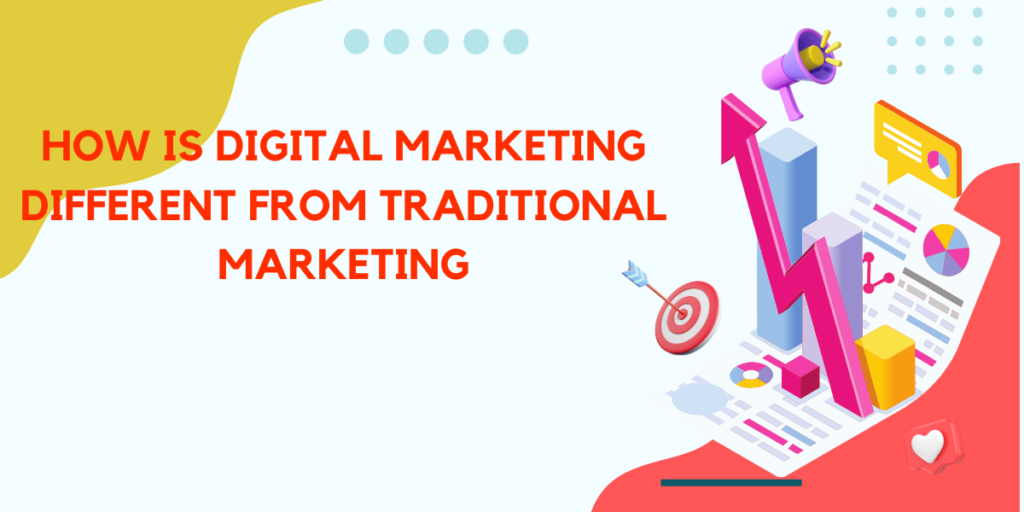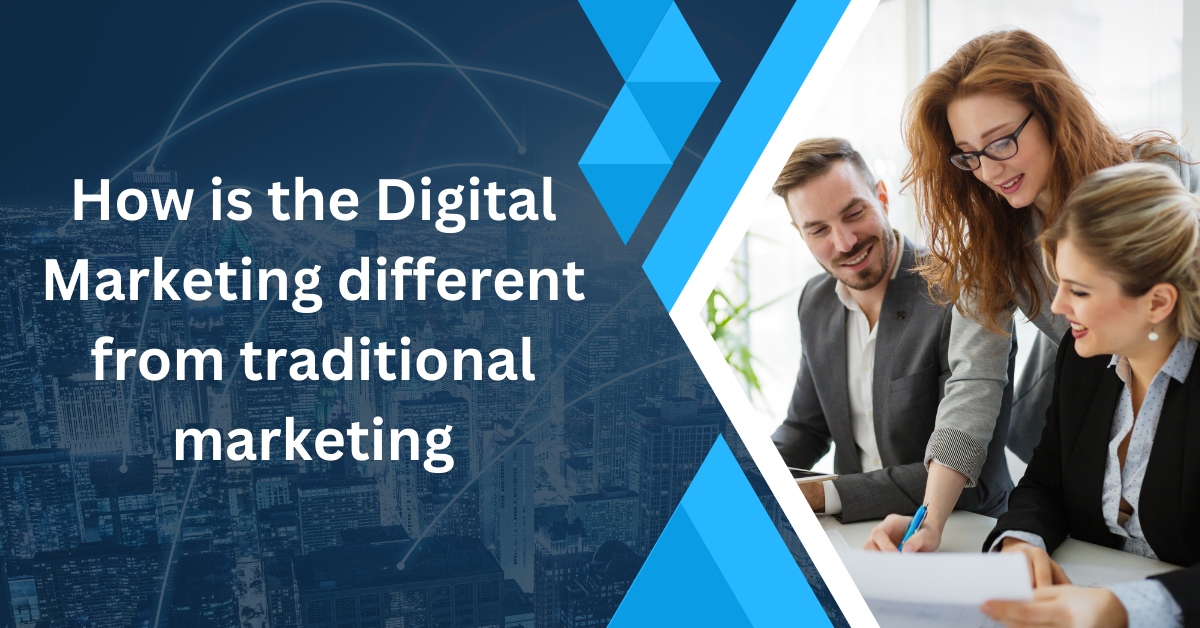Digital Marketing different from traditional marketing. Marketing uses many different tools and strategies, and it can feel like these tools and methods change every day. Keeping up with all these changes can be tough.
However,understanding the two key types of marketing—digital marketing and traditional marketing—is important.
Here’s what you need to know about each and how they compare.

Traditional Marketing:
Traditional marketing refers to using conventional channels such as billboards, print media, broadcast, telephone, and direct mail for advertising and promotions. It was the dominant marketing approach before the rise of digital marketing in the late 1990s, which coincided with the growth of the internet.
Digital Marketing:
Digital marketing uses websites, social media, and other online tools to connect with people. It’s all about using technology to reach customers better than before.
How do digital marketing and traditional marketing differ?
Traditional marketing methods like printed catalogues sent by mail, billboards along highways, TV commercials, newspaper ads, and other forms of print advertising.
Digital marketing, in contrast, involves promoting products or services through digital channels. This includes email marketing, social media campaigns, and any other digital content. The digital nature of these methods is what defines this field.
Digital marketing is a broad area that also includes content marketing, SEO optimization, paid search, and more.
How can we track the performance of these methods?
Before discussing how to measure the success of these strategies, let’s briefly compare costs. Traditional marketing methods are generally much more expensive than digital marketing. This is due to several factors. For instance, traditional marketing comes with many costs, including postage and billboard rentals.
Conversely, digital marketing can often be done at minimal or no cost. This affordability is a key reason why digital marketing has become a central component of many marketing plans.
Like social media promotions, email marketing is key for increasing sales and growing your brand. With good email lists and quality content, you can get ahead of your competition.
To see which works better, compare sales from digital marketing to sales from print ads. This shows which one brings in more sales.
For example, if your TV ads bring in more sales than your emails, you might need to improve your digital marketing.
Is it really important?
Knowing the difference between digital and traditional marketing is important for both marketing professionals and business owners. Managing a brand means you need to handle both traditional and digital marketing campaigns.
As global commerce speeds up, you must be able to manage these marketing channels easily. Digital marketing is especially important today because social media can reach more people than traditional methods.
To excel in digital marketing, focus on mastering social media and email marketing. These skills will help you create strong email content regularly.
One of the biggest mistakes in marketing is relying on just one marketing channel. If you’re still mainly using print ads in 2019, you’re falling behind.
The key is not to favour one form of marketing over the other. To make your marketing as effective as possible, use the best practices of both. This is essential for growing your brand today. Balancing both traditional and digital marketing is a skill you need to master to succeed.
Digital marketing and traditional marketing differ in several key aspects:
- Interaction and Engagement: Digital marketing allows for two-way communication and engagement with the audience through channels like social media, email, and interactive content. In contrast, traditional marketing typically offers limited interaction, such as through TV ads, print media, and billboards, where feedback and engagement are minimal.
- Cost-Effectiveness: Digital marketing often proves more cost-effective than traditional methods. For instance, running online ads or creating content for social media platforms can reach a wider audience at a lower cost compared to print ads or TV commercials, which require significant investment for limited exposure.
- Measurement and Analytics: Digital marketing provides robust tools for measuring campaign performance and audience behaviour in real time. Metrics such as website traffic, conversion rates, social media engagement, and email open rates offer valuable insights into campaign effectiveness. Traditional marketing methods, while they have tracking mechanisms like surveys and brand trackers, may not offer the same depth of analytics and real-time data.
- Reach and Targeting: Digital marketing enables precise audience targeting based on demographics, interests, behaviours, and other factors. This targeted approach increases the relevance of marketing messages and improves conversion rates. Traditional marketing methods often have broader reach but may lack the specificity and customization available in digital channels.
- Flexibility and Adaptability: Digital marketing allows for quick adjustments and optimizations based on real-time data and market trends. Campaigns can be modified, tested, and scaled rapidly, offering flexibility in response to changing consumer behaviour. Traditional marketing strategies, such as print ads or TV commercials, are less adaptable once deployed.
When digital marketing and traditional marketing work together, they can create a powerful marketing campaign. Take Coca-Cola and Guinness as examples of brands that have successfully combined both approaches for effective results.
Did you know that 57% of people globally spend an average of 6 hours and 42 minutes online each day? That’s quite a staggering number! This presents a huge opportunity for marketers to leverage digital channels.
In summary, while both digital and traditional marketing have their strengths and weaknesses, digital marketing often offers greater interactivity, cost efficiency, measurement capabilities, targeting precision, and agility in adapting to market dynamics. However, the optimal marketing approach depends on the target audience, industry, budget, and specific goals of the campaign.
FAQ’s
Is digital marketing superior to traditional methods?
Digital marketing is often seen as more cost-effective compared to traditional methods. With digital marketing, you can track ROI more accurately using analytics tools. This allows advertisers to optimise campaigns in real time, improving performance and efficiency. On the other hand, traditional marketing typically provides limited interaction with the audience.
What benefits come from integrating traditional and digital marketing approaches?
Combining traditional and digital marketing helps businesses reach customers at every stage of their journey, from discovery to after-purchase interactions. When you keep your messages and branding consistent across both traditional and digital platforms, you create a smooth and unified experience for customers.
How can traditional media contribute to enhancing a brand’s online presence and reputation?
In short, branding your business well means being flexible with how you use different media. Traditional media reaches many people and is trusted, while new media lets you target specific groups and see results right away.
Why is traditional media considered one-directional?
Traditional media is typically a one-way communication tool, designed mainly to inform or persuade an audience. For instance, a business might place an ad in a local newspaper or air a commercial on daytime television to quickly convey a message to its audience.
How does social media differ from traditional media according to Quora?
Social media lets you share your thoughts on news or any content, making it a two-way communication platform. Traditional media doesn’t offer this interaction. Building trust and customer commitment with traditional media takes considerable time.
What effects has social media had on the workplace?
Using social media at work can lead to problems like viruses and people being mean online. It could also cause bad publicity for the company.
https://digimarketinggyan.com/best-top-seo-company-in-india/
https://digimarketinggyan.com/is-digital-marketing-a-good-career/
https://digimarketinggyan.com/what-is-content-marketing-in-digital-marketing/
.https://digimarketinggyan.com/what-is-social-media-optimization/
https://digimarketinggyan.com/is-whatsapp-a-social-media-platform/
https://digimarketinggyan.com/is-you-tube-social-media-platform-everything-you-need-to-know/
https://digimarketinggyan.com/advantages-and-disadvantages-of-social-media-for-students/
.https://digimarketinggyan.com/is-social-media-getting-banned-in-india/
https://digimarketinggyan.com/what-is-the-digital-marketeting-funnel/
https://digimarketinggyan.com/digital-marketing-syllabus-2024/
https://digimarketinggyan.com/mba-in-digital-marketing-requirements-opportunities-and-earnings/
https://digimarketinggyan.com/what-is-performance-marketing/
https://digimarketinggyan.com/seo-interview-questions-and-answer/

